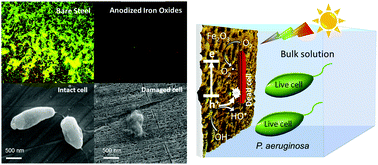当前位置:
X-MOL 学术
›
J. Mater. Chem. B
›
论文详情
Our official English website, www.x-mol.net, welcomes your
feedback! (Note: you will need to create a separate account there.)
Photocatalytic anti-bioadhesion and bacterial deactivation on nanostructured iron oxide films†
Journal of Materials Chemistry B ( IF 6.1 ) Pub Date : 2018-01-30 00:00:00 , DOI: 10.1039/c7tb03242k Yuan Li 1, 2, 3, 4 , Y. Frank Cheng 1, 2, 3, 4
Journal of Materials Chemistry B ( IF 6.1 ) Pub Date : 2018-01-30 00:00:00 , DOI: 10.1039/c7tb03242k Yuan Li 1, 2, 3, 4 , Y. Frank Cheng 1, 2, 3, 4
Affiliation

|
Bacterial adhesion and biofilm formation on metals are a primary mechanism causing integrity degradation and failure of engineering structures. Conventional anti-bioadhesion methods usually impact the sustainability of environments and ecosystems. In this work, nanostructured iron oxide films were fabricated by electrochemical anodization of steel in a concentrated alkaline solution. The morphology, surface roughness, composition and photoelectrochemical properties of the nano-films were characterized, and the anti-adhesion properties of the films to Pseudomonas aeruginosa bacteria were investigated. A photoelectrochemical based model was developed to explain mechanistically the photocatalytic anti-bioadhesion and bacterial deactivation of the iron oxide nano-films. Results demonstrate that the nanostructured iron oxide films enable effective anti-adhesion of the bacteria to the filmed steel. The photocatalytic activity of the nano-films further deactivates the bacteria remaining on the specimen surface under visible light illumination. In particular, the nano-film formed by 10 min of anodization features the largest surface roughness, the highest photocatalytic activity, and the best performance for anti-bioadhesion and bacterial deactivation. Compared to bare steel, a 99.9% anti-bioadhesion performance is achieved. The nanostructured iron oxide films can deactivate the bacteria remaining on the film surface due to oxidative holes and reactive oxygen species generated during photo illumination.
中文翻译:

纳米结构氧化铁膜上的光催化抗生物粘附和细菌失活†
细菌在金属上的粘附和生物膜形成是导致完整性下降和工程结构失效的主要机制。常规的抗生物粘附方法通常会影响环境和生态系统的可持续性。在这项工作中,通过在浓碱溶液中对钢进行电化学阳极氧化来制备纳米结构的氧化铁膜。表征了纳米薄膜的形貌,表面粗糙度,组成和光电化学性能,并表征了其对铜绿假单胞菌的抗粘附性能。对细菌进行了调查。建立了基于光电化学的模型,以机械方式解释了氧化铁纳米膜的光催化抗生物粘附和细菌失活。结果表明,纳米结构的氧化铁膜能够使细菌有效地抗粘附于成膜的钢。纳米膜的光催化活性进一步使可见光照射下残留在样品表面的细菌失活。特别地,通过阳极氧化10分钟形成的纳米膜具有最大的表面粗糙度,最高的光催化活性以及抗生物粘附和细菌失活的最佳性能。与裸钢相比,可获得99.9%的抗生物粘附性能。
更新日期:2018-01-30
中文翻译:

纳米结构氧化铁膜上的光催化抗生物粘附和细菌失活†
细菌在金属上的粘附和生物膜形成是导致完整性下降和工程结构失效的主要机制。常规的抗生物粘附方法通常会影响环境和生态系统的可持续性。在这项工作中,通过在浓碱溶液中对钢进行电化学阳极氧化来制备纳米结构的氧化铁膜。表征了纳米薄膜的形貌,表面粗糙度,组成和光电化学性能,并表征了其对铜绿假单胞菌的抗粘附性能。对细菌进行了调查。建立了基于光电化学的模型,以机械方式解释了氧化铁纳米膜的光催化抗生物粘附和细菌失活。结果表明,纳米结构的氧化铁膜能够使细菌有效地抗粘附于成膜的钢。纳米膜的光催化活性进一步使可见光照射下残留在样品表面的细菌失活。特别地,通过阳极氧化10分钟形成的纳米膜具有最大的表面粗糙度,最高的光催化活性以及抗生物粘附和细菌失活的最佳性能。与裸钢相比,可获得99.9%的抗生物粘附性能。










































 京公网安备 11010802027423号
京公网安备 11010802027423号